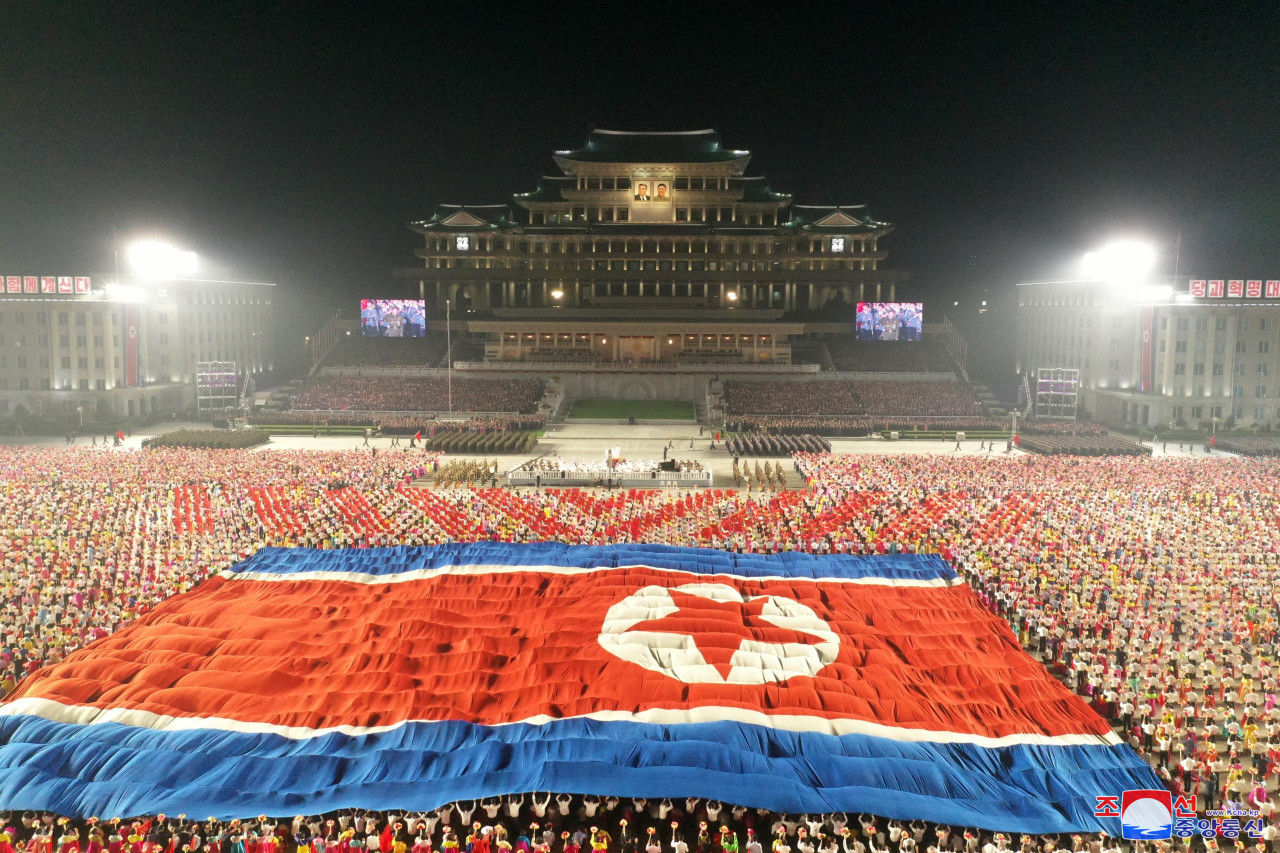NK holds parade without missiles amid nuclear standoff
By Choi Si-youngPublished : Sept. 9, 2021 - 15:32

North Korea held a military parade Wednesday at midnight to celebrate the 73rd anniversary of its founding, the official Korean Central News Agency said.
Similar midnight parades took place in January this year and in October last year. But this time, leader Kim Jong-un did not make a speech or reveal the latest missile, amid a nuclear standoff with the US. Pyongyang has refused to reopen dialogue with Washington.
The parade, attended by Kim, saw a show of force by the regime’s paramilitary and public security forces at Kim Il-sung Square. The South Korean government and experts believe the event has more to do with North Koreans than with those on the outside.
“Kim is reaching out to his people and not, say, us -- South Korea or the US. A parade without missiles or a speech makes everything more plausible that way, though it’s early to be definitive,” a Seoul official said.
The military said it was closely looking into the event with US intelligence, without elaborating. A military official said the regime seemed to have scaled down the parade, because this one was much shorter than the earlier ones and only lasted about an hour.
“They were paramilitary forces marching down at Kim Il-sung Square, meaning it wasn’t the usual ‘military’ parade we’ve seen in the past years. To me, this parade was to rally North Koreans,” said Cheong Seong-chang, director of the Center for North Korean Studies at the Sejong Institute.
Cheong said the paramilitary and public security forces, which can back up the regular military at anytime, were there to demonstrate the Kim family’s doctrine that every North Korean citizen should be ready to engage when called.
“The parade has just shown them how,” Cheong added.
He underscored the parade aimed to calm public frustration with the COVID-19-hit economy as well, citing a secretary of the regime’s ruling party who said during the parade that North Koreans should rely on no one but on themselves to tackle hurdles head-on.
Self-reliance or sufficiency is central to North Korea’s “juche” ideology, which dictates every agenda from domestic matters to foreign policy.
North Korea, which has shut down its border and has officially confirmed no COVID-19 infections, is grappling with vaccine shortages as it struggles to fight the perennial crisis involving food and sanitation.
But Pyongyang has rejected the offer of China’s Sinovac shots from COVAX, a global vaccine program, and rebuffed Seoul’s offer to work together on the COVID response. UNICEF has said North Korea is underprepared to receive any vaccines.
North Korea could be restarting building weapons using its nuclear reactors, according to a recent report by the International Atomic Energy Agency.
While the North is not expected to return to the stalled nuclear talks anytime soon, the South is preparing to discuss denuclearization with China next week, when Beijing’s top diplomat visits here.
Similar midnight parades took place in January this year and in October last year. But this time, leader Kim Jong-un did not make a speech or reveal the latest missile, amid a nuclear standoff with the US. Pyongyang has refused to reopen dialogue with Washington.
The parade, attended by Kim, saw a show of force by the regime’s paramilitary and public security forces at Kim Il-sung Square. The South Korean government and experts believe the event has more to do with North Koreans than with those on the outside.
“Kim is reaching out to his people and not, say, us -- South Korea or the US. A parade without missiles or a speech makes everything more plausible that way, though it’s early to be definitive,” a Seoul official said.
The military said it was closely looking into the event with US intelligence, without elaborating. A military official said the regime seemed to have scaled down the parade, because this one was much shorter than the earlier ones and only lasted about an hour.
“They were paramilitary forces marching down at Kim Il-sung Square, meaning it wasn’t the usual ‘military’ parade we’ve seen in the past years. To me, this parade was to rally North Koreans,” said Cheong Seong-chang, director of the Center for North Korean Studies at the Sejong Institute.
Cheong said the paramilitary and public security forces, which can back up the regular military at anytime, were there to demonstrate the Kim family’s doctrine that every North Korean citizen should be ready to engage when called.
“The parade has just shown them how,” Cheong added.
He underscored the parade aimed to calm public frustration with the COVID-19-hit economy as well, citing a secretary of the regime’s ruling party who said during the parade that North Koreans should rely on no one but on themselves to tackle hurdles head-on.
Self-reliance or sufficiency is central to North Korea’s “juche” ideology, which dictates every agenda from domestic matters to foreign policy.
North Korea, which has shut down its border and has officially confirmed no COVID-19 infections, is grappling with vaccine shortages as it struggles to fight the perennial crisis involving food and sanitation.
But Pyongyang has rejected the offer of China’s Sinovac shots from COVAX, a global vaccine program, and rebuffed Seoul’s offer to work together on the COVID response. UNICEF has said North Korea is underprepared to receive any vaccines.
North Korea could be restarting building weapons using its nuclear reactors, according to a recent report by the International Atomic Energy Agency.
While the North is not expected to return to the stalled nuclear talks anytime soon, the South is preparing to discuss denuclearization with China next week, when Beijing’s top diplomat visits here.
-
Articles by Choi Si-young



















![[Today’s K-pop] Treasure to publish magazine for debut anniversary](http://res.heraldm.com/phpwas/restmb_idxmake.php?idx=642&simg=/content/image/2024/07/26/20240726050551_0.jpg&u=)